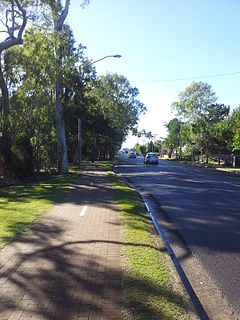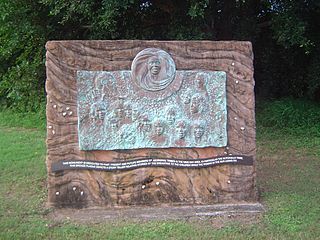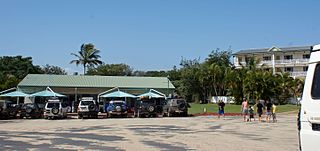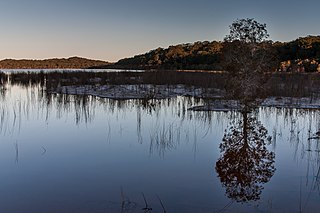
Great Sandy National Park is a coastal national park in the Fraser Coast Region, Queensland, Australia.

Fraser Island is a World Heritage-listed island along the south-eastern coast in the Wide Bay–Burnett region, Queensland, Australia. The island is approximately 250 kilometres (160 mi) north of the state capital, Brisbane, and is within the Fraser Coast Region local government area. The world heritage listing includes the island, its surrounding waters and parts of the nearby mainland.

Hervey Bay is a city on the coast of the Fraser Coast Region of Queensland, Australia. The city is situated approximately 290 kilometres (180 mi) or 3½ hours' highway drive north of the state capital, Brisbane. It is located on the bay of the same name open to the Coral Sea between the Queensland mainland and nearby Fraser Island. The local economy relies on tourism which is based primarily around whale watching in Platypus Bay to the north, ferry access to Fraser Island, accessible recreational fishing and boating and the natural north facing, calm beaches with wide undeveloped foreshore zones. In October 2019, Hervey Bay was named the First Whale Heritage Site in the world by the World Cetacean Alliance, for its commitment to and practices of sustainable whale and dolphin watching. A 2010 study by Deakin University showed that people on the Fraser Coast area including Hervey Bay, were the happiest in Australia. At June 2018, there were an estimated 54,674 people in Hervey Bay, having grown by an annual average of 1.31% year-on-year over the preceding five years.

Inskip Point is a peninsula in the north of the locality of Inskip to the north of the town of Rainbow Beach in south-east Queensland, Australia. It is the vehicular gateway to Fraser Island, a popular recreational area.

Double Island Point is a coastal headland in Queensland, Australia. It is the next headland north of Noosa and is within the Cooloola section of the Great Sandy National Park, at the southern end of Wide Bay. It is approximately 12km south along the beach from the tourist township of Rainbow Beach, Queensland.

Indian Head is a coastal headland on the eastern (ocean) side of Fraser Island off the coast of Queensland, Australia.

The Great Sandy Strait is a strait in the Australian state of Queensland of 70 kilometres (43 mi) length which separates mainland Queensland from Fraser Island. It is also a locality in the Fraser Coast Region local government area. In the 2016 census, Great Sandy Strait had a population of 4 people.

Rainbow Beach is a coastal rural town and locality in the Gympie Region, Queensland, Australia. In the 2016 census, Rainbow Beach had a population of 1,249 people.

Fraser Island is a locality on the island of Fraser Island in the Fraser Coast Region, Queensland, Australia. It consists of most but not all of the land on the island. In the 2016 census the locality of Fraser Island had a population of 182 people.

The geography of Queensland in the north-east of Australia, is varied. It includes tropical islands, sandy beaches, flat river plains that flood after monsoon rains, tracts of rough, elevated terrain, dry deserts, rich agricultural belts and densely populated urban areas.

Sandy Cape Light is a heritage-listed active lighthouse located on Sandy Cape, the most northern point on K'gari, Queensland, Australia. It stands about 6 kilometres (3.7 mi) southwest of the northeastern tip of the island. It is the tallest lighthouse in Queensland. Built in 1870, it is the second major lighthouse to be built in Queensland after its formation in 1859. It is one of the first lighthouses in Australia to be constructed using bolted prefabricated segments of cast iron, and one of only two such lighthouses in Queensland, the other being its sibling, Bustard Head Light.

Urangan is a coastal suburb of Hervey Bay in the Fraser Coast Region, Queensland, Australia. In the 2016 census Urangan had a population of 9,764 people.

Hook Point is the southernmost tip of Fraser Island in Queensland, Australia. It is the landing point for ferry services from Inskip Point, which is some 1,200 meters further south.
SS Marloo is a shipwreck at Great Sandy National Park, Fraser Island, Fraser Coast Region, Queensland, Australia. It was added to the Queensland Heritage Register on 12 October 2002 but delisted in 2015.

The Butchulla, also written Butchella, Badjala, Badjula, Badjela, Bajellah, Badtjala and Budjilla are an Aboriginal Australian people of K'gari, Queensland, and a small area of the nearby mainland of southern Queensland.

Happy Valley is a coastal town in the locality of Fraser Island in the Fraser Coast Region, Queensland, Australia.

Eurong is a town and a locality on Fraser Island in the Fraser Coast Region, Queensland, Australia. In the 2016 census, Eurong had a population of 47 people.
Tinnanbar is a coastal town and a locality in the Fraser Coast Region, Queensland, Australia. In the 2016 census, Tinnanbar had a population of 123 people.

Severe Tropical Cyclone Dinah was an intense tropical cyclone that impacted the southern coasts of Queensland and New South Wales, causing floods and landslides in 1967. It was regarded by an official in the Bureau of Meteorology's Brisbane Tropical Cyclone Warning Centre as the strongest storm to approach the southern coasts of Queensland since reliable records began. Forming on January 22 in the South Pacific basin, nearly 620 kilometers to the southeast of Honiara in the Solomon Islands, the disturbance that would eventually be Dinah remained disorganized until the next day when the system started to organize under the warm waters of the Coral Sea. On January 24, the disturbance was upgraded to a tropical cyclone by the BoM and was named Dinah, being the fifth storm in the records of the meteorology center of Australia in the 1966–67 Australian region cyclone season. Environmental conditions favoured Dinah to further intensify, becoming a severe tropical cyclone on January 27 while recurving south-southwestwards. On the next day, it passed through the Great Barrier Reef as a Category 4 severe tropical cyclone before passing through Fraser Island on January 29, where the Sandy Cape Lighthouse recorded a minimum barometric pressure of 944.8 hPa on Dinah, being the lowest known pressure of the system. It then battered the whole island before turning south-southeastwards, away from the coast of Queensland. Weakening took place while slowing down, passing near Lord Howe Island as a Category 2 tropical cyclone before undergoing extratropical transition on January 31. Dinah became extratropical on the night of that day before accelerating eastward, approaching New Zealand. The system then turned southeastward for the final time before passing through the North Island. It reemerged on the Southern Pacific Ocean on February 3, where it dissipated.

Lake Boomanjin is a large perched lake in the Fraser Coast Region of Queensland, Australia. The lake is located on Fraser Island in the Great Sandy National Park.




















